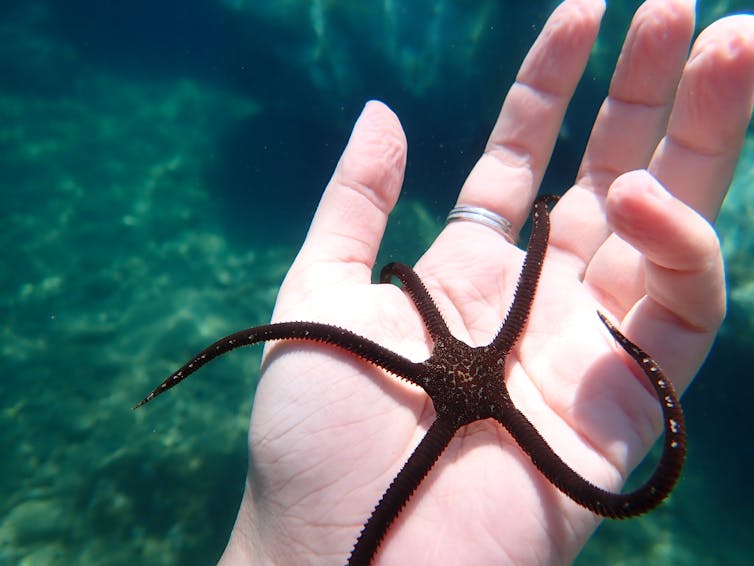One of the wildest wonders of nature is the ability of some animals to reproduce by splitting in half. There is still so much we don’t know about this process. So the discovery of a 155-million-year-old starfish fossil frozen partway through this process, published in a new study, could give scientists incredible new insights.
Our planet is teeming with invertebrates that, to our human eyes, may seem alien in the way they live and reproduce.
The starfish, or asteroid, is part of a group of animals called the echinoderms or spiny skinned animals that also includes sea lilies, sea urchins and sea cucumbers. They are found in almost every corner of our oceans and spend part of their life as microscopic larvae before developing into adults.
Starfish are among the oldest living animals on our planet. They appeared in a form we would recognise almost 480 million years ago and have survived five mass extinctions.
The reason for their evolutionary success could be in their ability to reproduce both sexually and asexually – by literally splitting in two and growing into two new animals. This is known as fissiparity. It is still sometimes observed in modern starfish and comes with the advantage of forming numerous offspring in a relatively short time and without “costing” the parent a great amount of energy or time.
Sexual reproduction, on the other hand, requires starfish and brittle stars to come together in huge numbers to spawn. The disadvantage of fissiparity is that this type of reproduction can result in a lack of genetic diversity in the population.
Biologists call the process of splitting in two parts fragmentation. Only a small number of animals can do this. For example, the common garden earthworm, which many gardeners have watched in amazement as one animal suddenly becomes two. Biologists can also watch starfish and brittle stars doing this in their labs or in marine stations.
But, until now, scientists weren’t sure how old this form of reproduction was. This phenomenon is most often seen in worm-like animals, and worm fossils are rare.
However, starfish can also split in two and have a much better fossil record. These animals still dominate our oceans, the deep seas are a carpet of them.

Rebirth of a fossil star
In the past ten years, Ben Thuy, a palaeontologist, has revolutionised the way we look at the evolution and biology of a group of starfish-like animals called the brittle stars or ophiuroids.
First by looking at how these animals have evolved, survived and then thrived in response to mass extinction events or ecological pressure. His work, studying the way their skeleton is made up of calcite plates, has changed our view of not only how the modern brittle star body shape appeared in the fossil record but also how we classify these animals.
In palaeontology, we are always searching for that key fossil that radically changes our view of how life evolved and developed on this planet. For example, the 2021 discovery of 480-million-year-old starfish-like animals in the Anti-Atlas mountains in Morocco helped us understand how these animals first appeared.
Such fossils are the holy grail of palaeobiology. They can give us a snapshot of the history of life and show us the moment a new animal first evolved on our planet.
Only a few animals make it into the fossil record, and many of these are in fragments as they often fall apart once the body has decayed. However, Thuy’s brittle star discovery appears to show a brittle star in the process of reproducing asexually. The fossil has already been “born”. One half of the body appears to be fully developed while the other half shows signs of regeneration with three smaller arms clearly visible.
This discovery means that we know that these animals were reproducing in this way 90 million years before the asteroid collision that wiped out the dinosaurs.
Scientists don’t always agree on what a fossil shows. There is a chance the brittle star fossil is a new species or an unusual individual that happens to have six arms rather than the typical five.
There are many examples of starfish that have more than five arms, including species such as Coscinasterias calamaria or 11 armed starfish. They can also gain an extra arm through natural genetic variation in the population similar to eye colour in humans.
But the study authors used comparative studies of other brittle stars that appear to have undergone regeneration to argue that their fossil originally had six arms before it split in two. Therefore, the authors say, the fossil must be the result of clonal fragmentation and the first in the fossil record.
If they’re right, fossils have allowed us to see the moment a new starfish was born in deep time.

